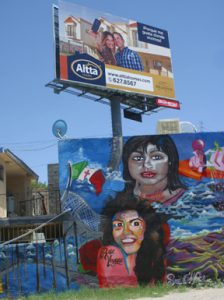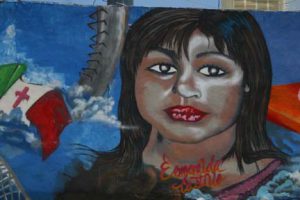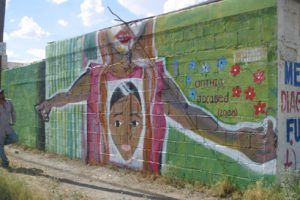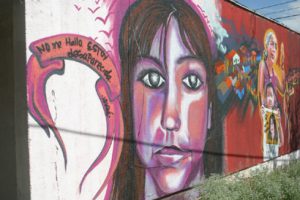Women Never Forgotten: The Murals and Memorials of Ciudad Juarez
Photos by Marisela Ortega
Text by Kent Paterson
Frontera NorteSur
Editor’s Note Frontera NorteSur is proud to publish this photo essay on a quiet cultural revolution that is visually transforming Ciudad Juarez while ensuring that memories and demands of justice for murdered and disappeared women are not swept under the rug.
Near the intersection of Vicente Guerrero and Lopez Mateos in Ciudad Juarez, local artist Maclovio describes a hypnotizing mural that honors three female victims of disappearance and homicide-Esmeralda Castillo Rincon, Rosa Virginia Hernandez Cano and Adriana Sarmiento. Conjuring up a sweeping and turbulent landscape, Maclovio and his helpers place the short lives of three girls and women in a world of militarism and nuclear bombs, migration and femicide, or feminicide- the systemic killing of women.
According to the 34-year-old muralist, the mural’s themes connect wars at home and abroad. Shown are important local landmarks including the Rio Bravo, or Rio Grande, the muddy and often water-starved river which both divides and unites Ciudad Juarez from its neighbor of El Paso, Texas; the U.S. army base of Fort Bliss; and “the country of femicides”, symbolized by a red cross in the center of the Mexican flag instead of the eagle, cactus and snake.
Splashed in purple and showered with raining crosses, the Navajo Arroyo in the Juarez Valley is shown at the bottom. Scores of murdered women have been recovered from the rural zone outside the city once famous for growing cotton since the 1990s. As Frontera NorteSur was going to press, officials had completed yet another search of the Navajo Arroyo, reportedly finding more bones, clothing fragments and women’s shoes.
“War demands bodies, the sacrifice of people,” Maclovio says.
EsmeraldaCastillo
The face of Esmeralda Castillo Rincon shines from the Vicente Guerrero mural, which is located a couple of blocks from the Rio Grande Mall near Juarez’s Pronaf zone. “She has brilliant eyes, but also a sad, worrisome look,” Maclovio says. Esmeralda was only 14 years old when she disappeared in downtown Ciudad Juarez.
A closer look at the Vicente Guerrero mural reveals a stairway leading from the scenery to a billboard situated above the apartment building where the big work of art stands. The billboard pitches a local subdivision where a beaming couple says they like living, and happy residents can enclose their lives from the outside world. “I liked this contrast,” Maclovio quips about the semiotic clash between the billboard and the mural. Like other murals, the Vicente Guerrero project, completed in the summer of 2015, was a collective effort.
Maclovio says victims’ relatives contributed to the design and painting, as did Perla Reyes, mother of Jocelyn Calderon (disappeared 2012) and Paula Flores, mother of Sagrario Gonzalez (disappeared and murdered 1998). Later in the day, Maclovio pulls out his phone and shows a photo of a rainbow that appeared after the mural group was painting one day and a storm burst from the heavens. “It was very symbolic, he says with a smile flashing across his face.
Located In a residential neighborhood off Paseo del Triunfo de la Republica, a wall mural on Calle Antonio Canalett honors Cinthia Jocabeth Castaneda. Only four days after celebrating her 13th birthday, Cinthia disappeared one October morning in 2008 when she went shopping for shoes and school supplies in downtown Juarez. In a 2014 interview with Frontera NorteSur, Karla Castaneda, Cinthia’s mother, described her daughter as a first-year middle school student who loved cooking, was close to a brother and dreamed of becoming a nurse when she grew up.
Cinthia Jocabeth Castaneda, who remains missing to this day, was among the first of many young girls and women from working-class backgrounds who vanished in the same manner in downtown Juarez from 2008 to 2012. Karla Castaneda, who clashed with authorities over her daughter’s disappearance, fled to the United States. Like other Juarez mothers, she says she was threatened because of her activism and relentless search for a daughter.
Another mural is painted on a house on Calle Antonio Canaleltt just blocks away from the work dedicated to Cinthia. This image shows Esmeralda Castillo, Juarez Valley murder victim Brenda Berenice Castillo, her son Kevin and her mother Bertha.
Like many other feminicide victims in Juarez, Brenda left behind a young child. Since the early 1990s, the border feminicide has created generations of orphans. How does one explain to a child how his or her mother died?
The mural contains words by Armine Arjona, a longtime women’s activist, acupuncturist and noted writer in the Paso del Norte borderland. Translated into English it reads:
“I can’t find myself. I am disappeared.”
Arjona was a close friend of fellow poet Susana Chavez, who was murdered at age 36 by three young men with purported gang ties in January 2011. In a 2014 interview with Frontera NortesSur, Arjona reminisced about her dear friend, calling Chavez “a unique and clear voice, a great poet.”
Although Susana Chavez has been dead for more than four years, her poems live on in cyberspace- potentially for eternity. See the link at the end of this article.
Back at the Vicente Guerrero mural, Maclovio stands at the image he and others produced. Part self-described vandal and part revolutionary architect, Maclovio might be described as a 21st century Paso del Norte Border Renaissance Man. An artist, muralist, poet, rapper, drummer and all around cultural hell raiser, the borderlander says he got a start as a young graffiti man secretly leaving his marks in the dark of the night. Maclovio once lived in East Los Angeles, where he thrived in the Graffiti Capital of the World.
Lluvia is Maclovio’s partner. Rejecting the label of an artist, Lluvia describes her role in the murals as an essential one of logistics, gathering up supplies and doing other tasks.
 Lluvia regards the February 2001 murder of 17-year-old mother and maquiladora (border factory) worker Lilia Alejandra Garcia Andrade as a turning point in her life. It so happened that on her walk to middle school every day Lluvia crossed the very same empty lot where Lilia Alejandra’s body was found dumped. Lluvia did not see Lilia Alejandra’s body but news of the murder and discovery of a homicide victim in a very familiar place, like a stab in the heart of the city, jolted a young Juarense’s sensibilities.
Lluvia regards the February 2001 murder of 17-year-old mother and maquiladora (border factory) worker Lilia Alejandra Garcia Andrade as a turning point in her life. It so happened that on her walk to middle school every day Lluvia crossed the very same empty lot where Lilia Alejandra’s body was found dumped. Lluvia did not see Lilia Alejandra’s body but news of the murder and discovery of a homicide victim in a very familiar place, like a stab in the heart of the city, jolted a young Juarense’s sensibilities.
“I was very nervous. I was 15 years old. I began to think a lot about the death of these women, their last months, how they died,” Lluvia says. About three years later Lluvia met Norma Andrade, Lilia Alejandra’s mom, and other members of Nuestras Hijas de Regreso a Casa (Return Our Daughters Home).
Not looking back, she became active in the fight against femicide and for the lives of women. “For me, it’s turned into my life. It’s my passion,” LLuvia says.
Lluvia and Maclovio say the reactions vary among people who run across their all-volunteer group painting the murals in honor of women.
“When I began, we started noting the reactions of the people,” Lluvia says. “Some people didn’t say anything. Some paused and really turned around. Some ask, ‘How much do they pay you? Does the government pay you?’ One asked, ‘Why do you do this is you don’t get paid?’” She says about others, “I think they don’t want to open their eyes and know that this is happening in our city.” Maclovio adds that surprised passerby nod in agreement when the purpose of the murals is patiently explained to them.
The mural movement dedicated to the women has taken on a life of its own. Maclovio and Lluvia say a second group has branched off from the original one and is erecting art work throughout the city. LLuvia estimates that 30 murals and stencil projects now grace her city. Jose Luis Castillo, father of Esmeralda Castillo, says the goal is to paint nearly 200 murals all over Juarez.
Only yards from Esmeralda Castillo’s memorial, at the intersection of Noche Triste (Sad Night) and Vicente Guerrero, stands another one for Silvia Elena Rivera Morales. Silvia is said to have disappeared from here, very close to where she was employed at a Tres Hermanos shoe store, in July 1995. The 16-year-old high school student’s raped and mutilated body was discovered on the outskirts of Juarez in September of the same year.
El Paso journalist Diana Washington Valdez spoke with Silvia’s mother, Ramona Morales, who described her daughter as a girl who was close to family. Silvia liked to dance at a hall inside the Zaragoza dairy, and loved the popular singer Selena. The Tejano sensation was murdered only months before the same fate befell one of her most devoted Juarez fans.
“Silvia cried inconsolably when she heard the shocking news,” Washington Valdez wrote in her 2006 book Harvest of Women.
20 years after Silvia Elena’s murder, no one has been punished for the crime. In a recent story, El Diario de Juarez noted that Ramona Morales has dutifully visited the state prosecutor’s office all these years looking for answers.
Justice cries out from a downtown ultilty post near the memorials for Maria Sagrario Gonzalez Flores. Abducted and murdered in 1998, Sagrario would have turned 34 on July 31, 2015. Paula Flores, Sagrario’s mom, told Frontera NorteSur that she celebrated her daughter’s birthday this year by going to the state prosecutor’s office, where she left flowers, repainted crosses and left posters.
One man was convicted of Sagrario’s killing, but other suspects remain on the loose, according to Flores.
Students, retail workers, domestic helpers, housewives, sex workers, and maquiladora (border factory) workers have all been among the girls and women murdered or disappeared in Ciudad Juarez since 1993.
Cited in the journal Aztlan, Juarez academic Dr. Julia Monarrez Fragoso, who’s done exhaustive research on the crimes and victims, documented the murders of 1,436 women in Juarez from 1993 to early December 2012. The toll does not include scores-perhaps hundreds-of women and girls disappeared to this day.
The Juarez victims were daughters, sisters, granddaughters, nieces, and mothers. Among them were hands that produced countless products consumed in the United States, unsung poets, saints and sinners, aspiring musicians, Sunday school teachers, and the future professionals of a generation that might have made a difference in the world.
Behind the downtown memorial for Esmeralda Castillo the Lear Corporation advertises for workers needed for the company’s Juarez operations. At a time of labor shortages in the local maquiladoras, the street ad promises a daily wage of barely seven bucks plus bonuses. Back in October 2001, Lear employee Claudia Ivette Gonzalez disappeared after she was refused entry to the plant on account of showing up a couple of minutes late.
The 20-year-old’s body was found the following month with seven other murdered girls and women at a vestigial cotton patch in the industrial center of Juarez that became known as the Campo Algodonero. The site was situated across from the headquarters of the maquiladora trade industry association and near the home of former Juarez Mayor Jaime Bermudez. Some analysts consider the so-called cotton field murders a macabre message.
Together with the mothers of two other Campo Algodonero victims, Claudia Ivette’s mom pursued justice all the way to the Costa Rica-based Inter-American Court of Human Rights, prompting a historic 2009 judgment holding the Mexican state responsible for permitting a climate of violence to prevail against women in Ciudad Juarez and the state of Chihuahua.
The new murals and memorials for women in Juarez represent a significant evolution in the justice movement for the women, as well as the use of public space and art to express messages and bear public witness. Since the 1990s, families and their supporters have staged marches, conducted hunger strikes and demonstrated outside government offices. They’ve taken their movement to Mexico City, the United States, Europe, Central America, the world over…
The murals and memorials are the latest markers in struggles to preserve family and collective memory. The works of community art and protest follow in the footsteps of the black/pink crosses painted by family members and their allies in the streets of Juarez, messages and poems spray painted on walls, the Cross of Nails sculpture erected at the foot of the Santa Fe Bridge leading into El Paso, and the makeshift crosses that were once set up at the Campo Algodonero, Lomas de Poleo and just off the Pan American Highway at the southern entrance to Juarez, where an official sign welcomes travelers to “The Best Border” anywhere.
For the poetry of Susana Chavez: http://primeratormenta.blogspot.com/


 Arturo Castañares
Arturo Castañares





